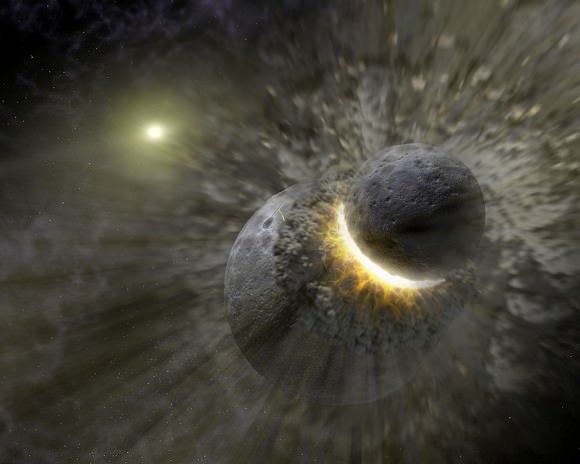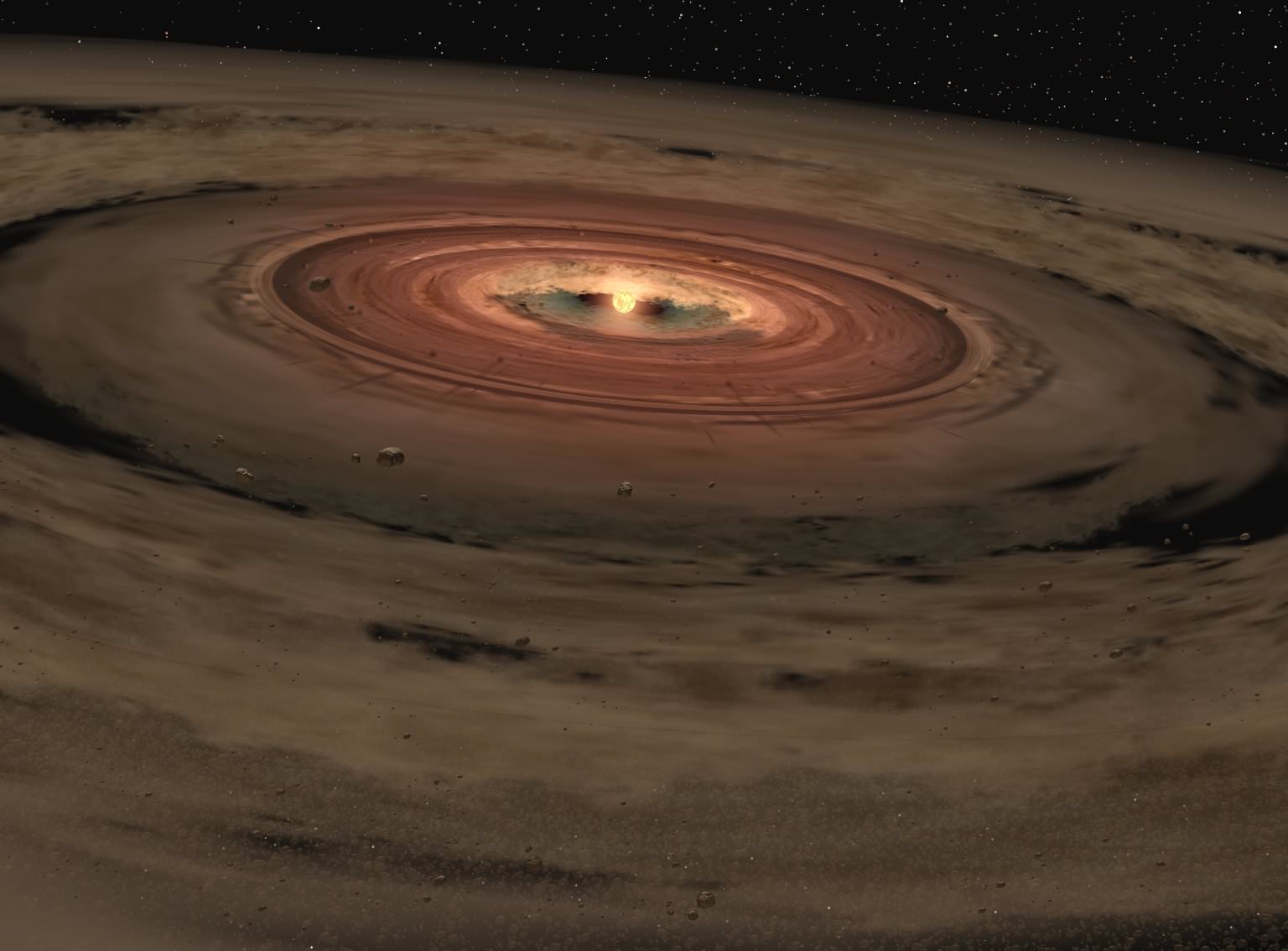When considering how the solar system formed, there are a number of problems with the idea of planets just blobbing together out of a rotating accretion disk. The Nice model (and OK, it’s pronounced ‘niece’ – as in the French city) offers a better solution.
In the traditional Kant/Laplace solar nebula model you have a rotating protoplanetary disk within which loosely associated objects build up into planetesimals, which then become gravitationally powerful centres of mass capable of clearing their orbit and voila planet!
It’s generally agreed now that this just can’t work since a growing planetesimal, in the process of constantly interacting with protoplanetary disk material, will have its orbit progressively decayed so that it will spiral inwards, potentially crashing into the Sun unless it can clear an orbit before it has lost too much angular momentum.
The Nice solution is to accept that most planets probably did form in different regions to where they orbit now. It’s likely that the current rocky planets of our solar system formed somewhat further out and have moved inwards due to interactions with protoplanetary disk material in the very early stages of the solar system’s formation.
It is likely that within 100 million years of the Sun’s ignition, a large number of rocky protoplanets, in eccentric and chaotic orbits, engaged in collisions – followed by the inward migration of the last four planets left standing as they lost angular momentum to the persisting gas and dust of the inner disk. This last phase may have stabilised them into the almost circular, and only marginally eccentric, orbits we see today.

Meanwhile, the gas giants were forming out beyond the ‘frost line’ where it was cool enough for ices to form. Since water, methane and CO2 were a lot more abundant than iron, nickel or silicon – icy planetary cores grew fast and grew big, reaching a scale where their gravity was powerful enough to hold onto the hydrogen and helium that was also present in abundance in the protoplanetary disk. This allowed these planets to grow to an enormous size.
Jupiter probably began forming within only 3 million years of solar ignition, rapidly clearing its orbit, which stopped it from migrating further inward. Saturn’s ice core grabbed whatever gases Jupiter didn’t – and Uranus and Neptune soaked up the dregs. Uranus and Neptune are thought to have formed much closer to the Sun than they are now – and in reverse order, with Neptune closer in than Uranus.
And then, around 500 million years after solar ignition, something remarkable happened. Jupiter and Saturn settled into a 2:1 orbital resonance – meaning that they lined up at the same points twice for every orbit of Saturn. This created a gravitational pulse that kicked Neptune out past Uranus, so that it ploughed in to what was then a closer and denser Kuiper Belt.
The result was a chaotic flurry of Kuiper Belt Objects, many being either flung outwards towards the Oort cloud or flung inwards towards the inner solar system. These, along with a rain of asteroids from a gravitationally disrupted asteroid belt, delivered the Late Heavy Bombardment which pummelled the inner solar system for several hundred million years – the devastation of which is still apparent on the surfaces of the Moon and Mercury today.
Then, as the dust finally settled around 3.8 billion years ago and as a new day dawned on the third rock from the Sun – voila life!


Oh, a time machine, a time machine, my kingdom for a time machine! *looks up* And a good umbrella, while your at it?
A recent article in NewScientist has suggested that “Neptune may have eaten a planet and stolen its moon” during that process.
Oh, I almost forgot, at the penultimate paragraph:
There’s a missing preposition “with” (between “along” and “a”) in that sentence, and also an inappropriate use of a “dash” there; it should be a comma.
Um… I’ll get my coat and see myself out…
Thanks Ivan3man_at_large – much appreciated (and fixed). Are you sure you can’t stay?
Interesting topic! We just covered our solar system formation in the Astrobiology course I’m attending. (It’s astrobiology anchored around Earth’s history.) The course book is devoid of the Nice model since it’s relatively new research, so this is interesting to see.
For one, the original papers don’t cover the terrestrial planets much. I have to assume this part, described above, becomes a natural part of the theory. (It is a de facto theory, I take it, it’s predictive in spades despite being concerned with likelihoods of pathways.)
Question for those in the know: The original simulations don’t give a Mars. Or, IIRC, speak much of an early/late veneer delivery for volatiles from belt asteroids as seems the likeliest pathway as per D/H ratios. Has any of that changed?
For another, the Neptune/Uranus switch is consistent with their atmosphere composition I believe. But it seems it “only” happens ~ 50 % of original simulations set up or the J/S 2:1 resonance. A pathway not taken is in there, though it’s not a bad likelihood for the actual outcome.
Another question: Has the predicted pathway (U/N switch) been robust in likelihood in later research?
Commenting on the remainder of the article, I’ll raise the same beef I had with the course book timeline sketches of Earth early history. It is a hypothesis driven, not data driven, suggestion often implicitly made that the LHB and life didn’t overlap.
Suggestions to the contrary comes from three independent sets of data.
First, the LHB may have ended more gradually according to Earth geological record, tailing as long as 3.2 Ga. This overlaps with certain evidence of life (stromatolites).
Second, actual modeling suggest that LHB was survivable for cellular life forms, even mesophiles. “Our analysis shows that there is no plausible situation in which the habitable zone was fully sterilized on Earth, at least since the termination of primary accretion of the planets and the postulated impact origin of the Moon.”
Seems a reasonable proportion of crust experienced a slight ~ 10 K temp local increase most of the time. That, and bacteria famously repopulates very fast, motile or not motile alike. LHB was aimed at a moving target.
I’m a mere student here, but I don’t see any negative reactions to this paper as of yet. (Scopus.) In any case if anyone wants to claim LHB was a sterilizer it seems to me they have some work to do.
Third, there are expected tests that observing a biosphere survives, up to earlier times. Besides those stromatolites which have a cut off by tectonics, there is an expected heavy carbon deficit in samples. They have been seen in rocks of Isua (~ 3.8 Ga), of Akilia (> 3.8 Ga), and in zircons of Jack Hill as graphite inclusions (~ 4.25 Ga).
It’ is not the only hypothesis that could explain a global supply of fractionated material. Other sources are heavy impact material (as previous supply perhaps, or as a later flow) or potential abiogenic catalytic pathways.
But demanding such exclusion is to put undue burden on tests, that are primarily aimed at rejecting a theory. (That a plane may crash into the ground for aerodynamic reasons, say by being flown inverted, doesn’t preclude gravitation exist.)
Personally, I don’t see how one can come up with a test that reject life after global temperatures dropped below the thermophilic limit, assuming water. A major liquid water supply is suggested by those zircon’s at ~ 4.4 Ga.
Pressures could still have been prohibitive at that time, i.e that water could have been above the thermophilic limit. But that is not known AFAIU. This is where the alternate hypothesis that life didn’t exist back then seem to fail a test, at least currently. So if you ask me today, that is where I would put my money on life.
Several years ago I read an article on numerical simulations of stellar system evolution. Some features of the NICE model were involved, such as inwards migrations. As things stand now I think these types of models will come and go pretty quickly. What is needed is a considerable sample space of stellar systems and on disk nebular regions with planetary formation.
LC
Pre-LHB life is certainly plausible as there was probably liquid water by then. There may not have been enough light for photosynthesis due to LHB dust clouds and a weaker Sun – so maybe life got started as anaerobic Archaea huddled around deep ocean vents. I don’t think there’s any fossil evidence pre-3.8 billion y.a. to allow more than speculation.
@ Steve Nerlich,
Well, I’m back… I can’t do without my daily fix of your (and not forgetting other authors) most excellent Universe Today articles.
Lawrence, Steve, I appreciate your responses. Seems we agree on the essential issues, and that we need more research to settle the raised issues. (Don’t we always?)
[Since I’m likely going to refer back to this article, some corrections on my previous comment:
“~ 4.25 Ga”: > 4.25 Ga.
“heavy impact material (as previous supply perhaps, or as a later flow)”: impact material (as previous supply perhaps, or as a robust flow).
“abiogenic”: abiotic.]
Far more data is needed. In some ways this is more mysterious than string theory. At least with string theory we have some basic quantum field theory to work with that we know empirically. Here we really seem to have very little as yet to work with. A serious data base of extrasolar systems is needed. I suppose the Kepler probe is cranking away to give some of that.
LC